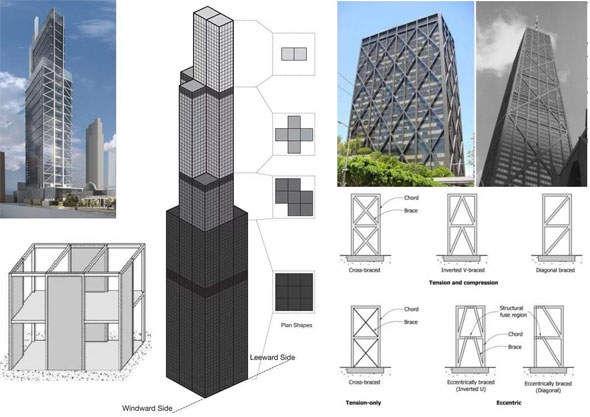Ground Floor Concrete Slab Detail
- Concrete Cost Estimator
- Concrete Continuous Footing
- Landscape Bidding and Estimating
- Construction Cost Estimating
- Concrete and steel cost estimation
- Construction Cost Estimate Breakdown
- Construction Estimating Worksheet
- Home Construction Cost Estimate
- Estimate Pricing Sheet
- Sheet for General Contractor
- Construction Cost Estimate
- Labor Materials Cost Estimator
- Masonry Estimating Sheet
- Sheet for Building Contractor
- Construction Schedule Bar chart
- General Cost Estimator Sheet
- General Construction Estimate
- Building and Road Estimating Sheet
- Detailed expense estimates
- Door and Window Takeoff Sheet
- General Construction Cost Estimating Sheet

The construction of high rise building is made possible with the use of elevators and quality building materials like rebars and cement. The amalgamation of these two (cement and rod) in construction is known as “reinforced cement concrete” (RCC) or reinforced concrete (RC).
It comprises of a flat horizontal surface known as beams, vertical members alias columns and flat planes alias slabs which is the floor we step upon. Reinforced concrete ground floor slab stands directly on the subsoil or foundation is called ground-bearing slab whereas the other slabs found in the building are known as suspended slabs. Reinforced concrete ground floor slabs offer huge benefits to any building which range from endurance against internal tensile forces, thermal comfort, stability, design, etc.
Reinforced concrete slabs significantly contribute to enhance the strength of a building and it is very useful for high-rise buildings. It can either be constructed on the job site or prefabricated. Given below, the step-by-step process for constructing a reinforced concrete ground floor slab of a high-rise building:
1. Getting the Building Permit: To construct a high rise structure, a building permit is essential to maintain the safety.
The proposed building should be constructed with adherence to standard or building code. For this purpose, the building plan and permit application, and a permit fee are necessary for review.
2. Excavation: Initially, a soil scientist examines the site to settle the depth of the foundation. Then the actual construction is commenced. After this, excavation work comprising of moving earth, rocks or other material out of the site is accomplished for developing the foundation of the building. Excavation is also carried out to eliminate unnecessary materials from the site. Ensure that the method statement for the excavation is sanctioned prior to start the work.
Also Read: How to study standard checklist of different types of construction works
3. Finish the concrete columns underneath ground level: As soon as the ground is excavated and the foundation is created, reinforced concrete columns, retaining walls, and shear walls are constructed which will function as a bearing channel for the structures above. The MEP works should also be taken into consideration while building up the columns below the ground floor.
4. Setting Up Forms of Slab: Slab forms comprise of horizontal load-bearing structure which provide support to the form-lining and transmit the forces into the shoring. Slab form is available in the form of a wooden structure or a pre-constructed metal which are attached jointly to highlight places and depth a slab should contain. The form also defines the type of joint to be utilized (either construction or contraction).
The formwork engineers should be liable for inspecting and ensuring that all formworks are acceptable before pouring in the concrete.
5. Steel Reinforcement Installation on the slab and beams: Once the forms are installed, placing of reinforced slabs is started. The steel beams, drop beams and extra bars are also installed in this phase to give support and add strength to the building.
6. MEP Service Installations: Mechanical, electrical and plumbing (MEP) works commence from the ground slab. MEP comprises of three technical work departments which work in tandem to complete the project successfully. It contains installation of electrical appliances, piping, etc. all directed towards keeping the building interior and exterior suitable for dwelling.
7. Inspection with the Engineer/Consultant: Once steel reinforcement and MEP rough-ins are placed, an inspection should be made by the engineer or a consultant to check and ensure that the layouts are good and bear the load that will be enforced on it. The inspection can also be done for slab forms to make sure that that they can retain the concrete when poured.
8. Inspection with the Municipality Engineer: The municipal authority should also examine the project to check whether it abides by the standard and determine if the project is running according to the filed building permit. The municipal engineer will examine the technical issues, operation and political interference in the project.
9. Pouring Concrete: If everything is found to be proper after inspections, the concrete is poured on top of the rods in the slab forms which are already arranged. Normally, the concrete is mixed and poured to build a slab with the machines like cement mixers and dispensers. Ensure that concrete vibrators are accessible throughout concrete pouring.
10. Curing the slab: Curing a concrete will defer drying shrinkage unless the concrete becomes adequately strong to stop shrinkage cracking. It also facilitates the slab to keep moisture in order that the concrete attain more strength. All these contribute to attain the design strength, stability, water tightness and wear resistance.
The least size of a reinforced concrete slab is confined to 4 times the nominal size of aggregate. Besides, the thickness of a slab is based on the location of the project, the type, and extent of the slab. The reinforced concrete ground floor slab can withstand different types of loads like dead loads, live loads, dynamic loads, wind and earthquake load by transmitting the forces to the ground/soil.

- Application of concrete calculator
- Roofing Calculator can streamline the roof estimating process
- House construction cost calculator
- Engineering column design excel spreadsheet
- Material Estimating Sheet with Excel
- Materials List and Cost Estimate Worksheet
- Concrete Slab Estimating Calculator Sheet
- Common types of foundations for buildings
- Online calculation of construction materials
- Estimating with Excel for the Small Contractor
- Concrete Beam Design Spreadsheet
- Virtual Construction Management app for construction
- Autodesk’s Project Skyscraper
- Reed Construction’s Reed Insight
- Manage your construction project documentation
- Costimator, the popular cost estimating software
- On Center Software for construction professionals
- Free Construction Estimating Software
- Plumbing Calc Pro
- Cost Estimate Worksheet
- HVAC Piping Quantity Takeoff Worksheet
- Construction Estimating Software Sheet
- Estimate Cost Templates
- Construction Punch List
- Construction cost estimating template consisting estimating basic
- Gantt Chart Template for Excel
- Download Civil Engineering Spreadsheets with Verification
- The Building Advisor Estimating and Budgeting Worksheet
- Spreadsheet for design of concrete bridge
- Construction Estimating Software Free








